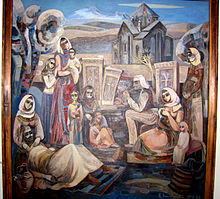
Back فن أرميني Arabic ཨར་མེ་ནི་ཡའི་སྒྱུ་རྩལ། BO Armenische Kunst German Armena arto EO Arte de Armenia Spanish هنر ارمنی FA Art arménien French Armenska umjetnost Croatian Örményország művészete Hungarian Հայկական արվեստ HY
| Part of a series on the |
| Culture of Armenia |
|---|
 |
| History |
| People |
| Languages |
| Mythology |
| Cuisine |


Armenian art is the unique form of art developed over the last five millennia in which the Armenian people lived on the Armenian Highland. Armenian architecture and miniature painting have dominated Armenian art and have shown consistent development over the centuries.[1] Other forms of Armenian art include sculpture, fresco, mosaic, ceramic, metalwork, engraving, and textiles, especially Armenian carpets.
Prehistoric Armenia was home to the Urartu culture in the Iron Age, notable for its early metal sculptures, often of animals. The region was, as later, often contested by the large empires holding the nearby regions of Persia, Mesopotamia and Anatolia. The Armenians adopted Christianity very early, and developed their own version of Eastern Christian art, with much use of icons, Armenian miniatures in books, and the very original architecture of their churches and monasteries. A distinctive Armenian feature, which may have influenced the Medieval art of Europe, was the popularity from early on of figurative relief carvings on the outside of churches, unknown in Byzantium.
Armenians specialized in arts and crafts such as carpet-weaving.
- ^ Kouymjian, Dickran (1992), "Introduction", The Arts of Armenia, Lisbon: Calouste Gulbenkian Foundation, retrieved 2009-05-10 "Introduction, Arts of Armenia (C) Dr. Dickran Kouymjian , Armenian Studies Program at Cal State University, Fresno". Archived from the original on May 30, 2009. Retrieved 2009-05-10.